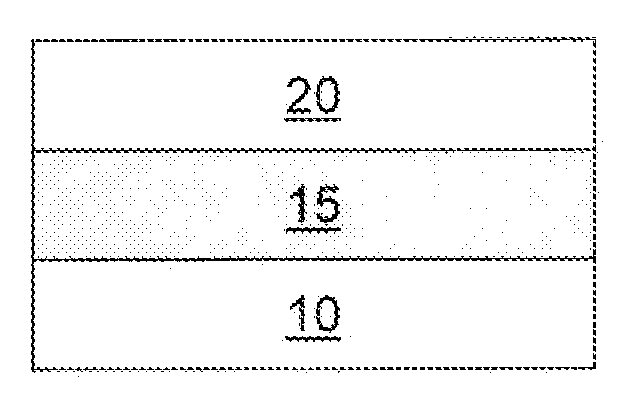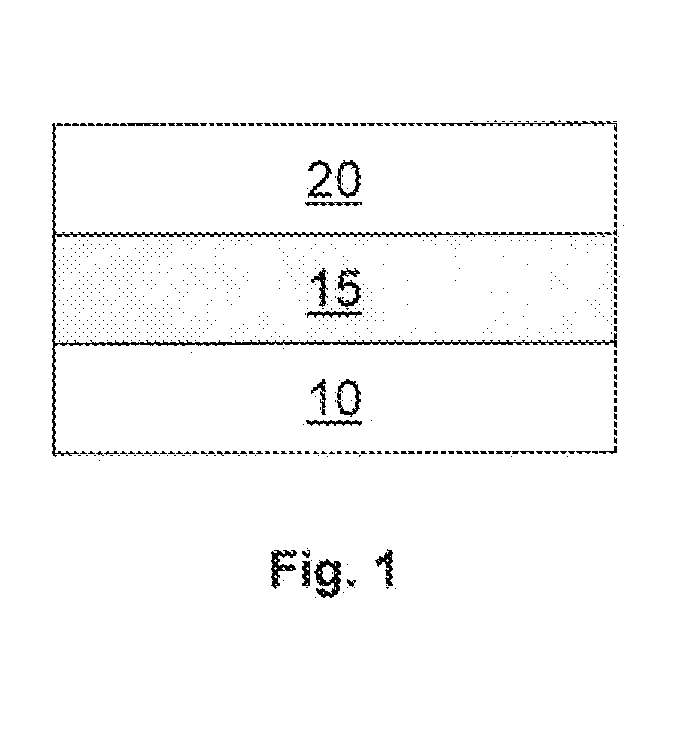Adhesive for bonding polyimide resins
a technology of adhesives and polyimide resins, applied in the direction of film/foil adhesives, synthetic resin layered products, animal housings, etc., can solve the problems of adding time and cost to production, affecting the stability of production,
- Summary
- Abstract
- Description
- Claims
- Application Information
AI Technical Summary
Benefits of technology
Problems solved by technology
Method used
Image
Examples
examples 1-9
[0066]Different article components were made using polycarbonate polysiloxane copolymers according to various embodiments.
Materials
[0067]Table 1 lists materials employed in the examples.
TABLE 1MaterialName / DescriptionSourcePolyimideAULTEM ® 1000 resinSABIC Innovative PlasticsPolyimide BULTEM ® XH 6050 resinSABIC Innovative PlasticsPolyimide CEXTEM ® HU 1004 resinSABIC Innovative PlasticsPolyimide DKAPTON ®DuPontpoly(4,4′-oxydiphenylene-pyromellitimide).Polyetherketone APEEK (amorphous) resinVictrexPolyetherketone BPEEK (crystalline) resinVictrexPolycarbonate CopolymerLEXAN ® FST resinSABIC Innovative PlasticsPolyetherimide foamULTEM ® FoamXP 060Sabic Innovative PlasticsPolycarbonate Copolymer BoardBoard made from LEXANSABIC Innovative PlasticsFST resin and glassULTEM ® / glass fabricCetex 2X Brand FabricTenCateInjection Molded Carbon FiberBonded with LEXAN ® FSTSabic Innovative PlasticsReinforced polyetherimideto ULTEM ® film (See:plaques bonded to aExample 12)polyetherimide filmPolyi...
examples
[0092]For the following examples, articles were made (or attempted to be made) by using including a plurality of substrates and an adhesive (that included a polycarbonate copolymer comprising reacted resorcinol, siloxane, and bisphenol-A) in accordance to the techniques and procedure described above. In all cases, the strength required to make layers of the articles separate was determined. There were two types of failures that could occur: (i) adhesive failure (where substrates of the articles separate from the adhesive and the separated substrate remain intact (ii) cohesive (substrate) failure (where one or more of the substrates fractures. As indicated above, a standard DeFelsco Positest procedures with 3M Scotch-Weld epoxy as the “dolly” adhesive was used to evaluate adhesion. The Examples are numbered in accordance to the number of the technique mentioned above. In some cases, examples were not available for an indicated technique.
examples 1 (
Examples 1(a)-(e)
Article Construction (Polyetherimide Film, Polycarbonate
[0093]The articles of Examples 1(a)-1(e) were made in accordance to the technique and procedures described above in section “1” of the Techniques & Procedure, i.e. at “Low Temperature” conditions. The strength required to make layers of the articles separate was determined as indicated above. We observed whether the failures that occurred was (i) an adhesive failure (where substrates of the articles separated from the adhesive and the separated substrate remained intact or (ii) cohesive (substrate) failure (where at least one substrate fractured or did not remain intact).
ThicknessSampleSample Construction(mm)1polyetherimide (ULTEM ® 1000) Film0.13polycarbonate copolymer (LEXAN ® FST) Film0.08polyetherimide (ULTEM ® 1000) IM Plaque1.75
Avg. Pressure Article isAdhesive or SubstrateExampleSubjected to (Mpa)Failure1-a3.7Substrate1-b2.8Substrate1-c3.1Substrate1-dXSubstrate1-e2.8AdhesiveAverage (1-a to3.11-e)
[0094]Dis...
PUM
| Property | Measurement | Unit |
|---|---|---|
| thickness | aaaaa | aaaaa |
| thickness | aaaaa | aaaaa |
| temperature | aaaaa | aaaaa |
Abstract
Description
Claims
Application Information
 Login to View More
Login to View More - R&D
- Intellectual Property
- Life Sciences
- Materials
- Tech Scout
- Unparalleled Data Quality
- Higher Quality Content
- 60% Fewer Hallucinations
Browse by: Latest US Patents, China's latest patents, Technical Efficacy Thesaurus, Application Domain, Technology Topic, Popular Technical Reports.
© 2025 PatSnap. All rights reserved.Legal|Privacy policy|Modern Slavery Act Transparency Statement|Sitemap|About US| Contact US: help@patsnap.com



